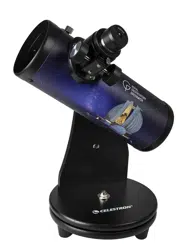Loading ...
Loading ...
Loading ...

ENGLISH | 7
Here are some suggestions on where to start in order of brightness:
The Moon
Your telescope will reveal excellent detail on the Moon. Try observing the “terminator,” the line of darkness
on the edge of the Moon’s disk. Observing along the terminator provides the best detail of craters and other
surface features. Try your higher-power eyepiece to see the Moon up close.
The Planets
Saturn and Jupiter are the best planets to observe. You can see the rings around Saturn and the moons of
Jupiter through your telescope. During certain times, you can even see the shadow of Jupiter’s moons on
Jupiter’s surface. Under good sky conditions you can observe cloud bands on Jupiter.
Venus will not show much surface detail, but you can see the phases from a thin crescent to a thick gibbous
as it moves around the Sun.
Mars will appear as a ruddy colored disk and, at times, may show a polar cap. The best time to view Mars is
when it is closest to Earth (called opposition). Due to the orbits of Earth and Mars, this only happens once
every two years, so make sure not to miss it!
Stars
Stars many not look any larger in your telescope, but they can still be interesting targets. Try observing single
stars to compare and contrast their varying colors. In the winter skies, the easily recognizable constellation
of Orion showcases two of the more extreme examples. Betelgeuse in Orion’s shoulder is very reddish, while
Rigel in Orion’s foot is very bluish-white.
Double Stars
Double stars, which are close pairs of stars, some of which are gravitationally bound, can also offer some
beautiful contrast. The star Albireo, which marks the nose of the swan in the constellation Cygnus, is a beautiful
example of a bright golden-yellow star with a dimmer blue companion star.
Star Clusters
Star clusters, or loose groups of stars are also beautiful targets. The Pleiades star cluster in the constellation
Taurus is a very close group of hot blue stars, visible to the naked eye on a dark night. Your telescope will reveal
beautiful gas clouds surrounding the cluster in a low power eyepiece. The Double Cluster in the constellation
Perseus, also visible with your low power eyepiece, is composed of two tight knit groups of stars. Another type
of cluster is a globular cluster. Its stars are so tightly packed together that it is difficult to differentiate individual
stars. The best example of this is the Great Hercules cluster in the constellation Hercules. This type of cluster
looks best in very dark skies away from city lights.
Nebulae
Nebulae can be very faint and difficult to see, but there are a few examples that are rewarding even from
suburban skies. The Great Orion Nebula in the constellation Orion is very easy to see. It appears as a collection
of stars that represent the “sword” hanging from Orion’s belt. In a low power eyepiece, you will see four stars in
a trapezoid pattern surrounded by a greenish-blue haze. Inside this vast nebula, new stars are being formed.
Under dark skies, this nebula can take up a sizable portion of the eyepiece.
Galaxies
Galaxies are notoriously difficult to track down, because they are extended objects with very low surface
brightness. This makes them hard to see unless you are under extremely dark skies, but there is one galaxy that
is fairly easy to find. The Great Andromeda Galaxy in the constellation Andromeda can just barely be seen with
the unaided eye in dark skies. It can even be seen with 10x50 binoculars from the suburbs. In the eyepiece,
you will see an elongated whitish glow, which may stretch across most of the eyepiece field.
When you look at pictures of nebulae in scientific publications you will see lot of red, blue and yellow nebulosity. The
view through the eyepiece does not look like this. Keep in mind that these published astroimages are created over long
exposure periods. Photographic film and image sensors can collect and store light over time, and are far more sensitive to
the many different colors present. Your eye, on the other hand, sees on an instant-by-instant basis and is most sensitive to
the green part of the spectrum. This is why most nebulae appear greenish-grey in the eyepiece.
SEEING COLOR
Loading ...
Loading ...
Loading ...
